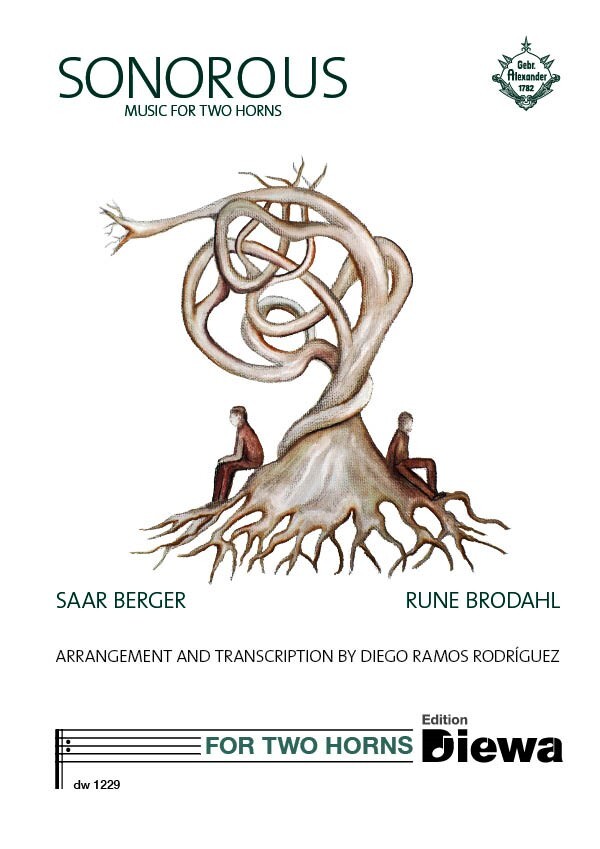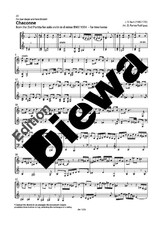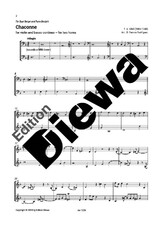Sonorous - Music for Two Horns - Notenausgabe
für 2 Hörner eingespielt auf CD von Saar Berger und Rune Brodahl
 Diego Ramos RodriguezVerlag:
Diego Ramos RodriguezVerlag:  Köbl EditionStil:
Köbl EditionStil:  Barock / RenaissanceAusgabe: Noten mit Audio-MaterialArt-Nr.: Z2533 / DW1229 Level:
Barock / RenaissanceAusgabe: Noten mit Audio-MaterialArt-Nr.: Z2533 / DW1229 Level: Besprechnung der CD Sonorous bei HR2 in der Sendung "Kulturzeit" besprochenSONOROUSEvery notation is, in itself, the transcription of an abstract idea(Ferruccio Busoni). A score does notretain the absolute truth about a musical work, it rather serves as astarting point for its various possiblerealisations. The first arrangement of a piece of music occurs when thecomposer writes the ideas downon paper. Moreover, every performance is in itself also an arrangement in awider sense, a collaborationbetween instrument, player and score which transports the music from thepaper to the ears of the listenerand thus transforms its substance while trying to keep its essence intact.The great pianist, composer and arranger Kaikhosru Shapurji Sorabji said thata good arrangment expounds,enlarges and amplifies matter and thought that has been left [...] todiscover and reveal. WhatI find exciting about this is that it opens the possibility to engage in adialogue on equal terms with thecomposer, where I can get to know the composer's music and tools, explorewhatever meaning they haveto me and pass this meaning on to the performers. It is a task that requiressubtlety, refinement, imaginationand authenticity and an important challenge as a composer.When Saar Berger and Rune Brodahl asked me to arrange the Chaconne forthem, I immediately thoughtabout some questions Bach and his contemporaries had to deal with threehundred years ago: in order tobe able to write complex harmonies and rich polyphonic counterpoints for onesingle melodic instrument,they transformed the diagonal playing techniques of the lute and adaptedthem to the violin and itsfamily among others. The technical limitations of the instruments were not ahurdle to overcome, but asource of musical creativity which was used to shape compositional ideas andtheir final realisation. Theinstrument-medium began to be used as an active component of the musicalprocess rather thana mere neutral tool to translate a score into sound. Having two horns athand, I decided to apply thesame strategy: I would break, unfold and share all hidden voices, chords andarpeggios between the twohorns, remaining faithful to the original but incorporating another set ofinstrumental possibilities. Inthoroughly polyphonic pieces like Bach's Chaconne or the Andante from the2nd Sonata, the two hornsmelt and intertwine, jumping among three or four different voices andsometimes creating the illusion ofa third horn which is not there in reality. In some cases, passages whichcould never be played by a hornalone (for example the long arpeggio chorals in Bach's Chaconne) aretransformed into genuinely newhorn textures unimaginable for the violin. In other cases, like Telemann'sFantasie 1, Bach's Allemandefrom the 2nd Partita, Biber's Passacaglia and Vitali's Chaconne, bothhorns take over one single melodicline, amplifying it and building its own harmony out of the resonance of someof the notes, as if they wereplaying in a large hall or a church. As a result, harmonic and melodicrelations only potentially present inthe original come to the surface, revealing perspectives of listening thatwere not possible before.Nevertheless, the most significant matter was to keep the essence of theoriginal works and at the sametime go beyond a mere transcription. As a violin player, the intimacy of thissolo pieces has influenced mymusical thought enormously: they involve a way of making and understandingmusic that is not presentin chamber or orchestral compositions. In the 18th century, this kind ofmusic was meant be played athome for personal entertainment, in private concerts for a small audience orsometimes in churches. Thatinfluences the degree of compositional detail and refinement and the kind ofinner virtuosity they requirefrom the performer (one could hardly imagine more different conditions fromthe ones where music forbrass instruments developed from: choral, symphonic, extrovert, often relatedto open-air events and bigaudiences). For this reason I had to think of a way of bringing this intimacyto the horn duo, making bothperformers not only play together, but interact as if they were one onlyinstrument. In these arrangements,whenever there is a dialogue, it is not a rhetoric one that creates a tensionto keep the musicalinterest; it is rather an internal one, where the two horns become the shadowof each other, smoothlyrecreating an illusion of polyphony while playing big leaps and quickfigures, and moreover integrating thesound colour, dynamic range and long expressive phrasing of the horn in akind of music which sometimesrequires lightness and flexibility. Saar and Rune's interpretation does notonly manage that, but alsodevelops new ways of sound that enrich the expressive possibilities of thehorn in a very personal way,opening a field which takes the music of Bach, Telemann, Vieuxtemps, Vitaliand Biber far beyond theclassical repertoire and deep into contemporary performance practice.DIEGO RAMOS RODRÍGUEZ







